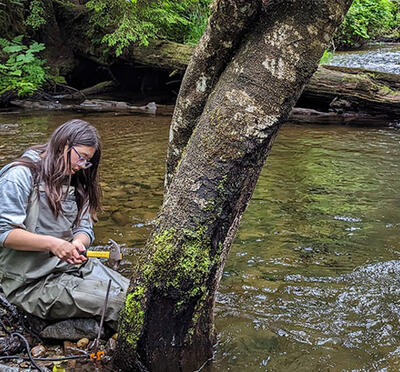Story updated on 8/13/2018.
An unusual opportunity came to Stephen Ramsey’s attention via a colleague’s Twitter post: “This is officially the craziest RFA (request for applications) I’ve seen …”
Curious, Ramsey, assistant professor of computer science in the College of Engineering at Oregon State University, clicked on the link, taking him to a National Institutes of Health site.
He could not have predicted what came next.
“It’s the first time I’ve ever had to solve a series of computer and mathematical puzzles in order to be able to read a funding opportunity announcement,” Ramsey said. “That was a new one.”
The project, sponsored by the National Center for Advancing Translational Sciences (NCATS), a branch of the National Institutes of Health, turned out to be the fulfillment of a dream for Ramsey. It offered a chance to help build a powerful tool that would bring together medical data from various sources, to better understand health and disease and, ultimately, to diagnose and treat patients more quickly.
Ramsey sought the help of colleagues to solve the puzzles and advance to the next step. The team he gathered has expertise that spans computer science, physics, mathematics, and the genetics of rare diseases. David Koslicki, assistant professor of mathematics at Oregon State, became Ramsey’s co-principal investigator on the project, and they partnered with two subcontractors — one headed by Eric Deutsch, senior research scientist at Institute for Systems Biology in Seattle, the other by Arnab Nandi, associate professor of computer science and engineering at Ohio State University.
What they have embarked on is a new model to accelerate biomedical discoveries. It’s not a grant or a contract — it is called an “other transaction” award. The award process is both competitive and collaborative.
It started as a competition. Once the team proved their computational abilities by solving the initial puzzles, they submitted a concept proposal which advanced them to them next stage of producing a prototype and detailed proposal for a reasoning tool. Of the 20 teams that solved the initial puzzles and submitted a concept letter, five were chosen to receive four months of funding to develop their idea.
After they received the funding, the process became much more collaborative, with the different teams learning from each other by regularly communicating and working together at hackathons.
“There is a very open culture — teams are readily sharing unpublished technology and results with one another for the furtherance of the project. There is an unusually high level of trust between the teams,” Ramsey said.
This unique approach by NCATS is meant to solve a difficult problem facing medical professionals and researchers: too much data. Specifically, there are terabytes of biomedical information that could help researchers generate new ideas for preventing, diagnosing, and treating diseases. But right now the data are siloed in different data sources that are often not compatible with each other.
The Biomedical Data Translator project seeks to develop a comprehensive system that will allow users to draw on data sources ranging from air quality measurements to electronic health records to answer questions such as “What diseases could aspirin treat?” or “What genetic conditions reduce your risk for osteoporosis?”
Ramsey and Koslicki’s received two rounds of funding in the first year, for a total of $788,443 which has been supporting students and staff who are working on the project. NCATS will make a decision about further funding once it has been able to review the progress of the teams.
“It’s a very flexible model which enables us to be nimble,” Ramsey said. “They can make adjustments to the deliverables to focus resources on things that are working, and not dedicate resources to approaches that aren't working.”



